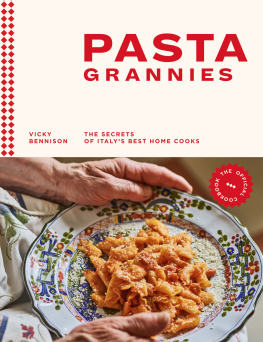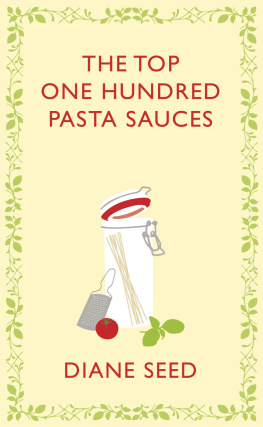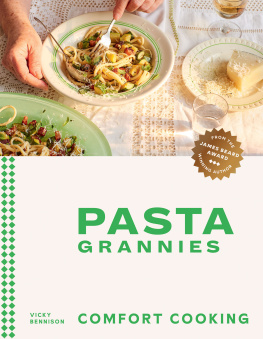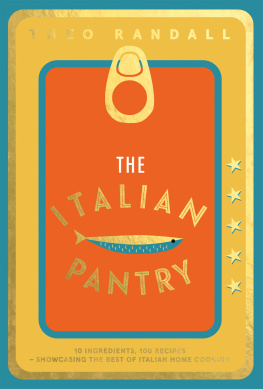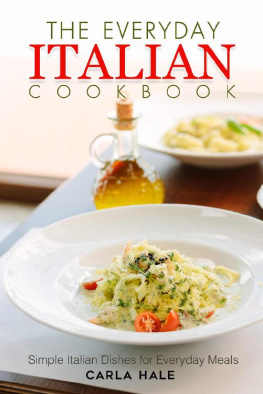





Early dawn in Italy belongs to the fishermen landing their catch, cheese-makers making curds and bakers paddle-sliding dough into their ovens. Theres another group of people stirring, too: grandmothers nonne making pasta for their familys lunch. Its the best time of day, they say, and for them, love is putting food on the table. In their collective past there was not the abundance and choice there is today. Food and family are to be cherished, and pasta is the perfect vehicle to make precious ingredients go further.
All Italians know their grandmothers are the best cooks, because they enjoy their Sunday lunch or daily meal served with a liberal sprinkle of adoration. Their nonne have cooked from scratch since they were old enough to roll dough and, by and large, only learn two or three pasta styles typical of their region. These vary dramatically from the cheese-and-butter-ladden gnocchi of the mountainous north to the homegrown tomato-based sauces served with knobbly and twisted pasta of the sun-soaked south. Some are familiar, like tagliatelle, others so obscure even other Italians dont know about them, such as maccarones de ungia from Sardinia.
Many nonne have their own vegetable patch, or orto, growing their own beans, onions and herbs not because it is cheaper, but because it tastes better. As one grandmother, Lucia, points out, when you have good ingredients, they do the work for you. And what isnt eaten immediately is bottled, pickled, placed under oil or dried for the winter months. All over Italy there are larders and cellars full of dried peppers, tomato passata and bejewelled jars of mixed pickled veggies. Every nonna has her own recipe; in fact, every nonna has her own recipe for everything. This book brings together the cooking of these women the Pasta Grannies as I call them. It features some of the women who have starred on the YouTube channel. The following pages reveal just how the story of that channel came about.

THE STORY OF PASTA GRANNIES
My first sighting of an Italian nonna was a pair of knees. Their owner, Maria, was sitting in the recesses of a deep veranda at the home of the Cardinale family in Serra de Conti, Le Marche. Producers of a local wild cherry wine called visciola, I had spent time with the Cardinales conducting an interview, after which they kindly invited me to share a meal with them later that day. When I arrived at their home, it was one of those perfect warm, late summer evenings, the full moon turning the sky a milky shade of plum. The garden was edged with poplar trees and hurricane lamps pockmarked the night sky, providing an other-worldly glow. Our long trestle table had been positioned outside on the terrace, close to the kitchen door, and it was covered with large chilled jugs of the local verdicchio wine, condensation droplets forming on the outside of the glass in the heat.
It was one of the first times I had been invited into an Italian home, and Nonna Maria had cooked up a feast. First there was the antipasti: spicy, grainy Parmigiano Reggiano and slivers of young pecorino, with garlicky discs of a local spreadable salami called ciauscolo. Then there were plump, ricotta-filled ravioli with a simple sauce made from warmed-through diced fresh tomatoes, shredded basil and grassy olive oil. This was followed by a rich meaty dish of boned and rolled-out rabbit stuffed with masses of chopped wild fennel fronds and garlic, then braised in white wine. I couldnt believe it was the work of just one person, and not a team of expert chefs. Everyone grinned and pointed to the shadows, where I spotted the aforementioned knees. Nonna Maria was eventually cajoled to the table, but she wouldnt join us. After smiles and delightful self-depreciation she disappeared back to her kitchen.
Living in Italy or indeed even if you dont it is hard not to be fascinated by the nations obsession with pasta. My neighbours dog happily eats pasta, the electrician goes home to his mums for lunch every day, while the plumber has a mobile kitchen in his van for those jobs too far from his own mother although both of them are married. My local town, Cingoli, with a population of only 10,000, sustains two fresh pasta shops. It is a subject taken seriously and valued with enormous importance. Speaking with the friendly manager of my local supermarket, Alessandro, I asked him what he knew about the local pasta dishes and, of course, he immediately volunteered his grandmother, another Maria (now 87 years old).
Alessandros extended family live in a row of stone houses in the Old Town. Even today, leaving home simply means moving next door for a lot of Italian families. Marias orderly kitchen was dark with wooden panelling, a central pendant light hanging in the middle and a small window. This was her kingdom, and she bustled about it, showing me little packets of frozen minced soffritto the Italian holy trinity of celery, onion and carrot, which is the base of most savoury dishes. I like to be organised. If Im going to chop vegetables I may as well do it for several meals! she declared, as she stuffed a stray bag of cappelletti pasta back into the freezer.


Maria was definitely the right person to ask about local pasta dishes and techniques. Having cooked for her own family all her life, in her retirement, Maria also took on the job of making pasta for one of Cingolis neighbourhood restaurants. She gets up at 3 a.m. every Wednesday to make ravioli and tagliatelle for the weekend rush. The chef is terrified shell retire for good.
Agreeing to show us her pasta-making skills, I invited Maria and her family to our house for lunch. Maria arrived with her pasta machine, untrusting of what I might have, and explained that she no longer uses the traditional rolling pin method thanks to the arthritis in her shoulders. Alessandro and his wife, Elisabetta, accompanied Maria, both keen to join in, and together we spent a happy few hours preparing lunch. The morning was conducted in English and Italian and everything in between, with a few games of charades when our languages failed us. Alessandro and Elisabetta were sous chefs, thrilled to be bossed around by Maria and announcing, Were going to do this again! Meanwhile, I was the utilities manager, running around looking for whatever knife or pan Maria declared she needed. Aside from the incredible pasta-making technique that Maria displayed, what also impressed me was how totally unfazed she was by cooking in a totally new environment and also that she didnt get any flour on her clothes the rest of us definitely did. Here was a woman with many years of experience behind her, sharing the skills she had honed over a lifetime, totally at ease with herself and those around her.

